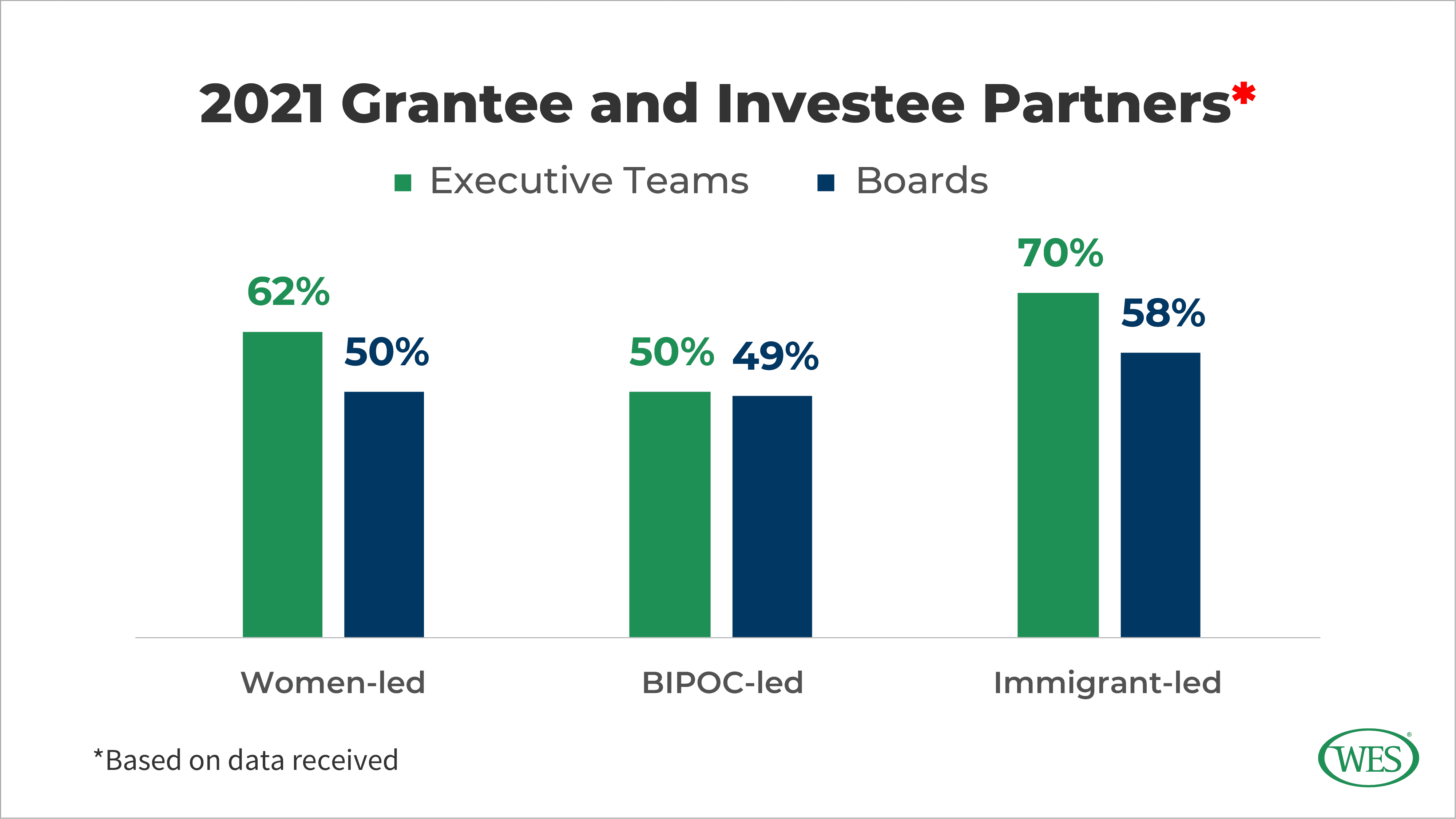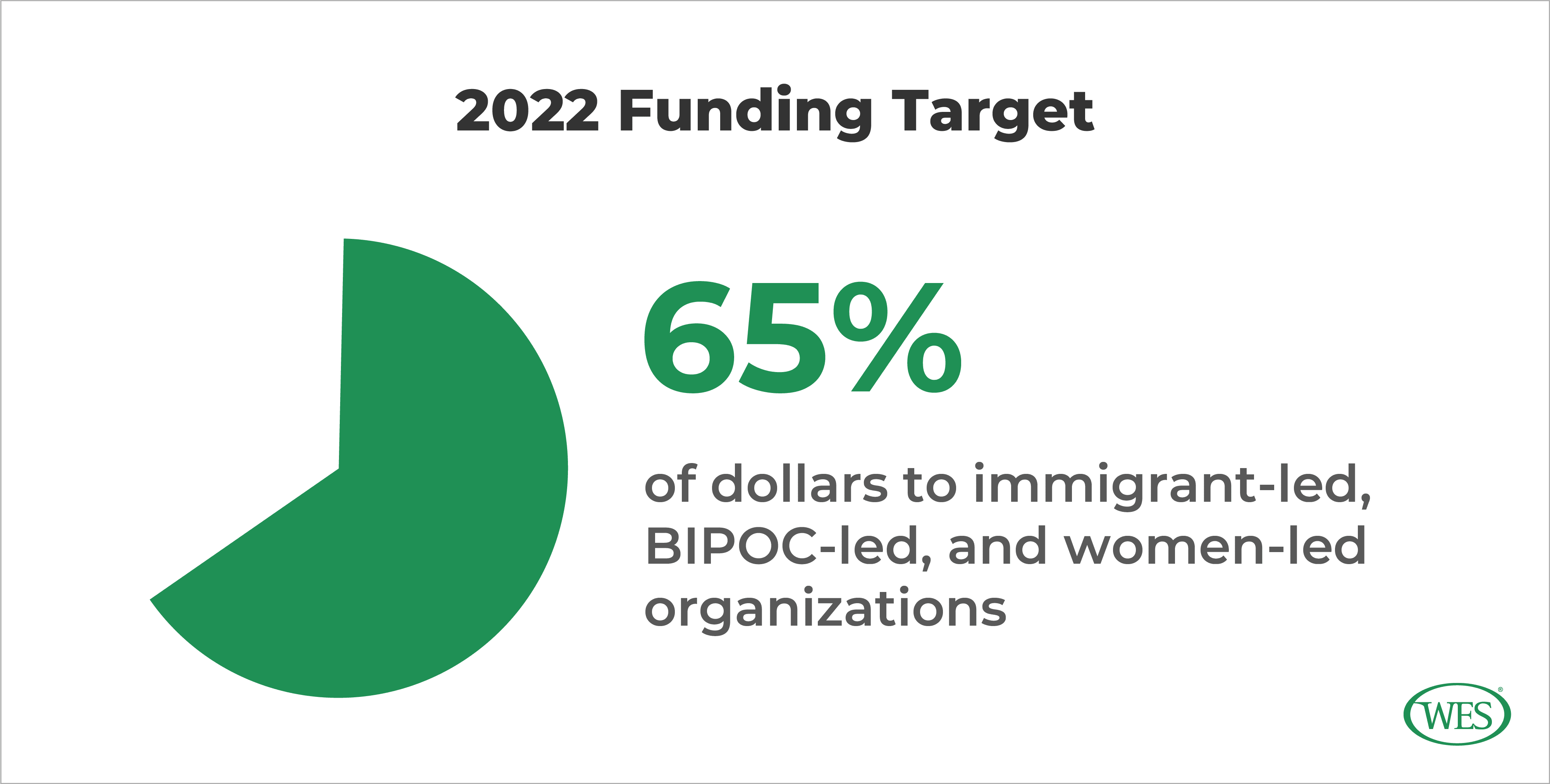Reflections on the Fund’s Justice, Equity, Diversity, and Inclusion Journey
In 2021, the WES Mariam Assefa Fund team set out to specify how we center justice, equity, diversity, and inclusion (JEDI) in our work. We asked ourselves what our priorities and philanthropic practices looked like, and the steps we could take to put equity at the forefront. As a funder focused on building more inclusive economies and communities for all, dismantling inequitable systems is inextricably tied to our mission. We are committed to shifting power to immigrants and refugees and being more flexible in how we fund.
Below, we reflect on our actions and learnings from 2021, and the steps we’ve been taking to build on these efforts in 2022.
First, we considered whom and what we fund, and asked how we can make our practices more equitable. We rolled out our first optional demographic data collection form related to race, ethnicity, gender, and immigrant identity for our funding applicants and partners.
This effort was key to our core goal of better understanding whom we are funding—and whom we are not— to identify inequities in how we support different communities. We also looked to establish metrics to increase funding for proximate leaders and organizations – leaders who come from the communities they serve and have direct experience or knowledge of the issues they seek to address, and organizations led and staffed by people with lived experience.
At the same time, we wanted the process of creating the form to be inclusive and meet the needs of our partners. We asked for a volunteer from each of our grantee and investee partner organizations to review our draft questions. We’re grateful that so many of our partners volunteered their time and provided valuable suggestions, like this one, to refine and improve this form:
“Just as the Fund is on a journey, it’s important to acknowledge that applicants and grantees are also on their own journeys, which, depending on resources and capacity, may also take some time and/or vary in comprehensiveness, compared to other organizations.”
We received data from 131 applicants and 47 grantee partners; 78% of organizations that applied for funding in 2021 and 77% of our Fund partners provided us with data.
We found that 70 percent of all the applicants we received data from were immigrant-led, 64% were Black, Indigenous, and people of color (BIPOC)-led, and 62% were women-led on their executive teams; of their boards, 63 percent were immigrant-led, 48 percent were BIPOC-led, and 48 percent were women-led.
When we looked at the data received just from our grantee and investee partners, we found that our partners had executive teams that were: 70% immigrant-led, 50% BIPOC-led, and 62% women-led. Their boards were 58% immigrant-led, 49% BIPOC-led and 50% women-led.
For 2022, we aim to increase these numbers. Our target is to award 65% of funding dollars to immigrant-led, women-led, or BIPOC-led organizations.
Upon reflection, we also acknowledge the shortcomings of our 2021 round of initial analysis. From the executive teams of BIPOC-led organizations that we collected data from, there is a disparity between who applied and who was ultimately funded. After conversations with our team and Board’s Fund Committee earlier this year, we identified action items for 2022 to bridge this gap. These include refining eligibility criteria to better assess relevant lived experience and incorporate more intentional analysis of demographic data at each stage of the selection process.
We also recognize that these categories are imperfect and that our breakdown has yet to capture the nuances of intersectional identities. As a funder committed to backing immigrant and refugee leaders, we are eager to dig further into the data to explore how we’re supporting leaders and organizations that bring multiple levels of lived experience, such as women who identify as immigrants and BIPOC.


Second, we thought deeply about how we structure our funding, and identified ways to become a more flexible funder.
To truly support the success of proximate leaders, organizations, and communities, we as a funder provide the resources they need to do their work. We found opportunities to provide more general operating support grants and simplify our reporting requirements to ensure that they are as flexible and supportive as possible.
In 2021, 23% of our grants were general operating support. Our goal for 2022 is that 40% of all grants approved will be structured as general operating support, allowing our partners to determine where resources are most needed. This flexible funding creates opportunity for innovation, emergence, and impact for our partners and allows us the opportunity to foster trusting partnerships with the communities we fund.
Third, we continue to adapt the ways we do philanthropy to better co-create solutions and share and shift power.
The Fund has an ongoing commitment to trust-based philanthropy. We continue to assess how we can show up better as a funder – with humility and transparency – and honor community-based wisdom and expertise.
As we worked to address the power imbalances inherent in philanthropy, in 2021, we began piloting participatory grantmaking initiatives to shift decision-making power directly to communities. 58% of our funding that year delegated some aspects of the funding process – such as review and prioritization of applicants, decision-making for selection – to external partners who bring relevant lived and learned experience to the funding process.
In November 2021, we launched our first participatory grantmaking model in partnership with Tamarack Institute to support the economic mobility of immigrants and refugees in the Peel region of Ontario, Canada. Tamarack worked with community stakeholders to identify the needs of immigrants and refugees in the Peel community, define funding priorities, and make community-led funding decisions.
In 2021, we launched an open call for funding applications to improve employer practices in both the United States and Canada. As part of this opportunity, we worked with a group of external reviewers who shared their perspectives and experiences to help select funding recipients. From this group of reviewers, 50% brought immigrant experience, 70% self-identified as BIPOC and 70% self-identified as women.
Moving forward, we want to do more to shift decision-making power. Our 2022 goal is that 60% of total dollars awarded to new partners will use participatory practices, which we have defined as partnering with external reviewers with representative lived experiences, delegating decision making to proximate communities or organizations, and supporting pooled funds with participatory or democratic governance.
Finally, we created internal opportunities to foster a more inclusive culture through procurement, trainings, and recruitment.
As a smaller funder, our team is partnering with external consultants and vendors as part of our extended team. In May, we began to gather optional demographic data from prospective contractors and set a target for 50% of our 2022 contractor and vendor spending to go to immigrant-led, women-led, and/or BIPOC-led firms.
Our team members participated in more than five communities of practice and leadership development initiatives, focused on racial equity in the philanthropic sector, addressing power imbalances, and more. Starting in 2021, we began to collect data on our own team’s representation as well. In 2022, WES hired a director of diversity, equity, inclusion, and belonging. We will be working closely with the director to ensue this data like this is captured across WES, and we will continue to ensure that our team includes diverse voices and lived experiences.
To embed equity into our recruitment practices, we brought on a firm, Axis Talent Partners, to lead the search for our new senior director. A key reason Axis stood out and they were selected is that they focus on creating access and opportunity for people of color and historically marginalized identities. Through this search, we have been piloting how we can incorporate anti-bias for hiring training into a search process.
What’s Next?
We recognize that these actions are our start, not our end. As a young philanthropic funder launched in 2019, we are committed to creating space for honest reflection and transparency as we seek to continuously improve.
One of our long-term goals is to ensure that our partners have the resources to build internal capacity for justice, equity, diversity, and inclusion. For us to effectively do this, our first step is to take an inward look. We are energized by our new partnership with Just Strategies, who is evaluating our practices and will complete an equity report of the Fund as an accountability measure that aligns our internal and external priorities and establishes goals. Looking at the ecosystems we work within, we will also continue to explore how our funding can best contribute to efforts addressing the systemic barriers to power and financial and social capital that many BIPOC- and immigrant-led organizations experience.
We’ll work to hold ourselves accountable to sharing our progress and we encourage our partners and peers to reach out with feedback.
Stay in Touch
Thank you for your interest in the WES Mariam Assefa Fund. We’ll share updates on the Fund’s efforts, what we’re learning, and opportunities through our email list.